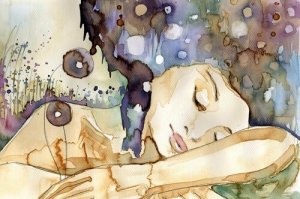The Mystery of Dreams

Some people choose not to pay attention to their dreams, while others think about them a lot. And some people think that dreams are the desperate cry of the things we don’t say when we’re awake. There are many different theories and research studies about dreams, and many hypotheses about what happens in the mind while we’re asleep.
Why do we dream? What do dreams mean? Where do the images come from that appear in our minds? How are nightmares formed? The answers are not simple at all, and many questions still haven’t been answered. The ones that have, we’ll discuss in this article.
Dreams: more than just REM
We’re not going to talk about the stages of sleep, or even the stages of REM that we go through when we close our eyes at night. But we will talk about what happens in the mind in relation to the images that appear, often without meaning or explanation.
Some studies suggest that everything we do during the day is accumulated in a specific area of the brain, and when we’re asleep they’re “brought to light” again, but in a mixed up, symbolic, and incoherent way. These can include a piece of news that you read, a movie that you saw, or a building that called your attention while you were walking to work, etc.

Images, sounds, memories, and experiences come together to make up the dream, like a summary of everything that happened that day. But of course, it’s not only composed of such current elements. They’re often combined with echoes of the past, things that happened a while ago or people you remember.
The experience of dreaming
We all dream, even if we don’t remember it. Even if we try to recount a dream or write it in a journal, we often lack most of the pieces we would need to assemble a puzzle that has any meaning or that we can apply to daily life. Nobody can ever portray it in exact detail. Even if you remember some parts vividly, there are still many parts that you can’t remember.
According to Allan Hobson, when you dream, the mental activity that occurs is very similar to the activity produced if you were actually doing the action, although there are certain elements that are impossible when you’re awake (e.g. seeing a family member who has passed away, flying like a bird, or seeing yourself as a child).
When you dream, it’s not just the brain that springs into action, but also feelings and even muscles. Fear, happiness, and uncertainty take over. You can wake up with your heart beating really fast, bathed in sweat, or short of breath. But most of the time, dreams occur without rhyme or reason, and they disappear sneakily when you open your eyes or hear the sound that wakes you up.
Why? It all depends on various factors. Firstly, it depends on the stage of sleep you’re in. If you’re in REM, the images and experiences are clearer, more extensive, and more perceptual. You might not be able to separate dream from reality. If you’re in an nREM stage, there will be less imagery, and more scenes typical of daily life (at work, cooking, in the park, etc.).
What is the function of dreams?
The main objective of sleep is to restore the organism to optimal physiological conditions. But in terms of the psychological, it often involves a lot of emotional content which should not be ignored.

Studies have demonstrated that dreams consolidate memories and help to effectively recover memories. Some theories also state that dreams provide the brain with the stimulation it needs to be able to wake up from a deep sleep and activate the brain circuits associated with emotions.
Theories about dreams
Sigmund Freud was convinced that dreams disguised repressed desires. He always used to say “there’s a lot of water that runs under the bridge.” New theories have appeared in the 20th century that either confirm or refute his hypothesis.
One of these theories is the one by Harvard psychologist Deirdre Barret, who said that dreams serve to resolve problems while we’re asleep. This means that humans have evolved to the point where we can solve problems even when we dream. How nice would it be if that happened all the time!
Dreams are quite visual, but not usually very logical. So for them to help us solve problems, we have to analyze them in more detail. That’s all well and good, but you have to keep in mind that we only remember parts of them. According to this theory, dreaming is another way of thinking, and it can help us to make a “plan B” for our problems.
On the other hand, psychiatrist Jie Zhang proposed another idea about dreams and their functions. According to him, the brain stores memories all the time, regardless of whether we’re asleep or awake.
This means that dreams are the same as the thoughts or memories that come to our minds when we’re awake. Think about it, have you ever been surprised by what you’re daydreaming about? Something similar happens when you go to sleep, only in this case it could involve unconscious activity that you can’t control.
This text is provided for informational purposes only and does not replace consultation with a professional. If in doubt, consult your specialist.








